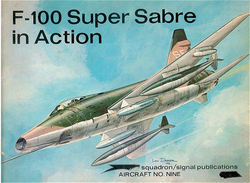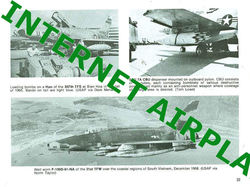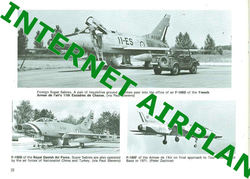SQUADRON SIGNAL F-100 SUPER SABRE IN ACTION USAF NATO
VIETNAM (DRENDEL)
SQUADRON SIGNAL
PUBLICATIONS AIRCRAFT No.9 (1973)
BY LOU DRENDAL.
INTRODUCTION (YF-100
PROTOTYPE, F-100A, 479TH TFW GEORGE AFB, M39 20mm CANNONS)
F-100D DETAILS
(TDU-10 DART TARGET, ZEL JATO LAUNCH, 510TH TFS TAKHLI RTAB, FT
LEONARD WOOD)
F-100F TWO-SEATER
(EDWARDS AFB, INSTRUMENT PANEL PHOTOS, 20TH TFW, IOWA ANG)
F-100D USAF
THUNDERBIRDS AEROBATIC DISPLAY TEAM
FOREIGN AIR FORCES
(FRENCH AIR FORCE ARMEE DE L�AIR, ROYAL DANISH AIR FORCE DENMARK)
F-100 HUN AT WAR
(VIETNAM WAR, NAPALM, 2.75-INCH FFAR, 416TH TFS, 481ST
TFS, 416TH TFS, COLOR ILLUSTRATIONS / COLOR PHOTOS (MISSOURI AIR
NATIONAL GUARD ANG, COCKPIT, 481ST TFS TAN SON NHUT AB RVN, 3RD
TFW, 612TH TFS, 307TH TFS, 31ST TFW, 481ST
TFS, BIEN HOA AB, 8TH TACTICAL FIGHTER WING, 35TH TFW,
614TH TFS, 352ND TFS, PHU CAT AB, 306TH TFS
TUY HOA AB, 308TH TFS, 615HT TFS
NEW MEXICO ANG
USAFE SABRES 9493RD
TFS, 48TH TFW, 20TH TFW, 4950TH TEST WING, 110TH
TFS MISSOURI ANG
YOU WILL FIND GREAT DEALS ON HARD-TO-FIND AVIATION,
ARMOR, NAUTICAL AND MILITARIA MAGAZINES AT MY EBAY STORE �INTERNET AIRPLANE
MAGAZINES AND BOOKS�!
I
HAVE HUNDREDS OF ADDITIONAL LISTINGS USING THE SIMPLE �BUY-IT-NOW� FORMAT. I
SPECIALIZE IN AVIATION REFERENCE MAGAZINES AND BOOKS. I ALSO CARRY TITLES ON
MILITARY HISTORY, ARMOR, TANKS, SHIPS, ELITE SPECIAL UNITS AND AMERICAN CIVIL
WAR. THESE ARE EXCELLENT GIFTS & REFERENCES FOR PILOTS, MILITARY AIRCREW,
VETERANS, MILITARY RE-ENACTORS, SCALE MODELERS & AIRCRAFT ENTHUSIASTS.
TITLES CURRENTLY LISTED INCLUDED: THE ELITE, TAKE OFF, WARPLANE, PROFILE
PUBLICATIONS, AIRCRAFT ILLUSTRATED, AIRCRAFT ILLUSTRATED EXTRA, AIR COMBAT, AIR
ENTHUSIAST, AMERICAN AIRMAN AND THE ILLUSTRATED ENCYCLOPEDIA OF AIRCRAFT.
HARD TO FIND GIFTS FOR
SCALE MODELERS, PILOTS, AIRCREW & VETERANS
HERE'S
AN INEXPENSIVE FATHER'S DAY GIFT, BIRTHDAY PRESENT OR CHRISTMAS PRESENT FOR THE
VETERAN, REENACTOR, SCALE MODELER, MILITARIA ENTHUSIAST OR HISTORY CHANNEL
LOVER IN YOUR FAMILY
PAYMENT INSTRUCTIONS:
AFTER
THE AUCTION HAS COMPLETED, YOU WILL RECEIVE AN INVOICE FROM ME. PAYPAL
ACCEPTED. ALL AUCTIONS MUST BE COMPLETED WITHIN 10 DAYS. I WILL DO MY PART AND
SHIP ASAP AFTER RECEIVING PAYMENT (SEE MY FEEDBACK FILE).
MONEY BACK GUARANTEE!
YOU
WILL LOVE MY CUSTOMER FRIENDLY RETURN POLICY. I WANT YOU OR YOUR GIFT RECIPIENT
TO BE HAPPY WITH YOUR PURCHASE. I GUARANTEE THAT THE ITEM SHIPPED WILL BE AS
DESCRIBED. YOU MAY RETURN THE ITEM WITHIN 14 DAYS FOR ANY REASON. JUST EMAIL ME
AND RETURN POST THE PACKAGE ADEQUATELY PROTECTED AGAINST SHIPPING DAMAGE) AND I
WILL RETURN YOUR ITEM PURCHASE PRICE IN FULL.
I WILL POST
POSITIVE FEEDBACK FOR YOU AFTER THE TRANSACTION IS COMPLETE AND I AM REASONABLY
SURE THAT YOU HAVE RECEIVED THE ITEM. IF THERE IS ANY PROBLEM, PLEASE EMAIL ME
TO WORK THINGS OUT BEFORE LEAVING FEEDBACK. MY GOAL IS TO LEAVE EVERY CUSTOMER
100% SATISFIED WITH MY PRODUCTS AND SERVICE.
------------------------------------------------------------------------------------------------------------------
Additional Information from
Internet Encyclopedia
The North American F-100 Super Sabre was a
supersonic jet fighter aircraft that served with the United States Air Force (USAF)
from 1954 to 1971 and with the Air National Guard (ANG) until 1979. The first
of the Century Series collection of USAF jet fighters, it was the first USAF
fighter capable of supersonic speed in level flight. The F-100 was originally
designed by North American Aviation as a higher performance follow-on to the F-86
Sabre air superiority fighter.
Adapted as a
fighter bomber, the F-100 would be supplanted by the Mach 2 class F-105
Thunderchief for strike missions over North Vietnam. The F-100 flew extensively
over South Vietnam as the Air Force's primary close air support jet.
The F-100 also
served in other NATO air forces and with other U.S. allies. In its later life,
it was often referred to as "the Hun," a shortened version of
"one hundred.
The definitive F-100D aimed to address the offensive
shortcomings of the F-100C by being primarily a ground attack aircraft with
secondary fighter capability. To this effect, the aircraft was fitted with
autopilot, upgraded avionics, and, starting with the 184th production aircraft,
the Sidewinder capability. In 1959, 65 aircraft were modified to also fire the AGM-12
Bullpup air-to-ground missile. To further address the dangerous flight
characteristics, the wing span was extended by 26 in (66 cm) and the
vertical tail area was increased by 27%.
The first F-100D
(54�2121) flew on 24 January 1956, piloted by Daniel Darnell. It entered
service on 29 September 1956 with 405th Fighter Wing at Langley AFB. The
aircraft suffered from reliability problems with the constant speed drive which
provides constant-frequency current to electrical systems. In fact, the drive
was so unreliable that the USAF required it to have its own oil system to
minimize damage in case of failure. Landing gear and brake parachute
malfunctions claimed a number of aircraft, and the refueling probes had a
tendency to break away during high speed maneuvers. Numerous post-production
fixes created such a diversity of capabilities between individual aircraft that
by 1965 around 700 F-100Ds underwent High Wire modifications to standardize the
weapon systems. High Wire modifications took 60 days per aircraft at a total
cost of US$150 million. In 1966, Combat Skyspot program fitted some F-100Ds
with an X band radar transmitter to allow for ground-directed bombing in inclement
weather or at night.
In 1961, at England
AFB, Louisiana, (401st Tactical Wing), there were four fighter-bomber
squadrons. These were the 612th, 613th, 614th and the 615th (Fighting Tigers).
During the Berlin Crisis (approximately September 1961) the 614th was deployed
to Ramstein Air Base, Germany to support the West Germans. At the initial
briefing, the 614th personnel were informed that due to the close proximity of
the USSR, if an ICBM were to be launched, they would have only 30 minutes to
launch the 614th aircraft and retire to the nearest German bunker.
In 1967, the USAF
began a structural reinforcement program to extend the aircraft's service life
from the designed 3,000 flying hours to 7,000. The USAF alone lost 500 F-100Ds,
predominantly in accidents. After one aircraft suffered wing failure,
particular attention was paid to lining the wings with external bracing strips.
During the Vietnam War, combat losses constituted as many as 50 aircraft per
year. On 7 June 1957, an F-100D fitted with an Astrodyne booster rocket making
150,000 lbf (667.2 kN) of thrust successfully performed a zero length
launch. This was accomplished with the addition of a large canister to the
underside of the aircraft. This canister contained a black powder compound and
was ignited electro-mechanically, driving the jet engine to minimal ignition
point. The capability was incorporated into late-production aircraft. After a
major accident, the USAF Thunderbirds reverted from F-105 Thunderchiefs to the
F-100D which they operated from 1964 until it was replaced by the F-4 Phantom
II in 1968.
The Hun was also
deployed as a two-seat F-100F model which saw service as a "Fast FAC"
or Misty FAC (forward air
controller) in North Vietnam and Laos, spotting targets for other
fighter-bomber aircraft, performing road reconnaissance, and conducting SAR
(Search and Rescue) missions as part of the top-secret project Commando Sabre,
based out of Phu Cat and Tuy Hoa Air Bases. It was also the first Wild Weasel SEAD
(air defense suppression) aircraft whose specially trained crews were tasked
with locating and destroying enemy air defenses. Four F-100F Wild Weasel Is
were fitted with an APR-25 vector radar homing and warning (RHAW) receivers,
IR-133 panoramic receivers with greater detection range, and KA-60 panoramic cameras.
The APR-25 could detect early-warning radars and, more importantly, emissions
from SA-2 Guideline tracking and guidance systems. These aircraft deployed to Korat
Royal Thai Air Force Base, Thailand in November 1965, and began flying combat
missions with the 388th Tactical Fighter Wing in December. They were joined by
three more aircraft in February 1966. All Wild Weasel F-100Fs were eventually
modified to fire the AGM-45 Shrike anti-radiation missile.
F-100F: Two-seat
training version, armament decreased from four to two cannon. First flight: 7
March 1957; 339 built.
DF-100F: This
designation was given to one F-100F that was used as drone director.
NF-100F: Three
F-100Fs used for test purposes, the prefix "N" indicates that
modifications prevented return to regular operational service.
TF-100F: Specific Danish
designation given to 14 F-100Fs exported to Denmark in 1974, in order to
distinguish these from the 10 F-100Fs delivered 1959�1961.
QF-100: Another
209 D and F models were ordered and converted to unmanned radio-controlled FSAT
(Full Scale Aerial Target) drone and drone directors for testing and
destruction by modern air-to-air missiles used by current U.S. Air Force
fighter jets.








